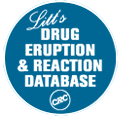In order to deliver a personalised, responsive service and to improve the site, we remember and store information about how you use it. This is done using simple text files called cookies which sit on your computer. By continuing to use this site and access its features, you are consenting to our use of cookies. To find out more about the way drugeruptiondata.com uses cookies please read our 'Cookie Policy'.
- TRADE NAMES: Chloractil; Chlorazin; Chlorpromanyl; Esmino; Largactil; Novo-Chlorpromazine; Ormazine; Propaphenin; Prozin; Thorazine (GSK)
- INDICATIONS: Psychosis, manic-depressive disorders
- CLASS: Antiemetic, Antipsychotic, Muscarinic antagonist, Phenothiazine
- HALF-LIFE: initial: 2 hours; terminal: 30 hours
- CLINICALLY IMPORTANT, POTENTIALLY HAZARDOUS INTERACTIONS WITH:
Alcohol, Antihistamines, Arsenic, Asenapine, Chlorpheniramine, Dofetilide, Epinephrine, Evening Primrose, Guanethidine, Lisdexamfetamine, Mivacurium, Pimavanserin, Propranolol, Quinolones, Sodium Picosulfate, Sparfloxacin, Tetrabenazine, Zolpidem
- See adverse reactions attributed to class:
The prolonged use of chlorpromazine can produce a gray-blue or purplish pigmentation over light-exposed areas. This is a result of either dermal deposits of melanin, a chlorpromazine metabolite, or a combination of both. Chlorpromazine melanosis is seen more often in women.
INCREASED MORTALITY IN ELDERLY PATIENTS WITH DEMENTIA-RELATED PSYCHOSIS
See full prescribing information for complete boxed warning.
Please login to view the rest of this drug profile.
Page last updated 08/29/2023




